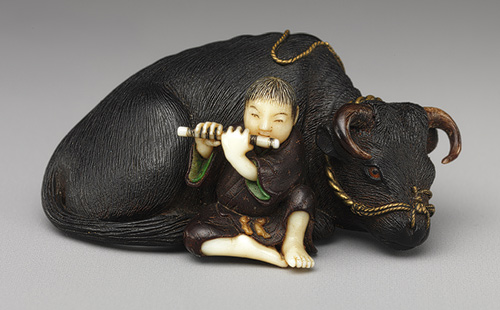Inro (‘seal-basket’) are small decorative containers that hang from the waist. They originated at the end of the sixteenth century and were worn by men to hold seals and herbal and other medicines. They were considered a particularly good way of keeping the contents sealed and fresh. By the eighteenth century they had become decorative accessories and were commissioned by the merchant class, provincial rulers and their samurai, and those that could afford them.
In the 1870s the Japanese government encouraged men to adopt a more western style of dress such as hats, jackets and trousers. The use of inro therefore dwindled and many fine examples were collected by British collectors and museums.
Inro are made from very thin leather, wood or paper covered in decorated lacquer. They consist of separate sections stacked on top of each other, and are kept together by a cord loop that passes through a channel on each side and underneath the bottom section. The sections are held together when the cord is tightened by pulling it through a bead (ojime), rather like the toggles used in outdoor clothing. The cord is then passed behind the waist sash (obi) so that the inro hangs freely from the waist. To prevent the inro from slipping through the obi, a small and often decorative toggle (netsuke) is attached to the end of the cord.
There is no fixed form of decoration. As with other objects, surfaces are decorated with a variety of subjects: figures were popular, sometimes engaged in the performing arts; monkeys, lions and oxen can also be seen; the changing seasons occur frequently.
The Japanese lacquer work on inro is so beautiful, yet it is such a difficult medium to work with, as well as being a time consuming process. Not only does it involve building up a very large number of layers before any decorative work can be introduced, but there are also then several different very fine skills required in completing the decoration. Techniques involve using coloured lacquer, shell inlay, metal work and amazing applications of tiny bits of gold. What is extraordinary too, is that having completed the decoration, the lacquer and any metal, or shell decoration, often can be quite thick, yet all the inro sections fit into each other so smoothly that when the inro is closed, all one can see, are very fine lines that are really the dividing gaps between the various compartments.
This photograph* shows a fine wood netsuke of a mouse eating a bean, the pod beneath him. Japan, late 19th century. Signed: Tomokazu, Gifu. Provenance: Tomkinson Collection. The ojime is lacquered with crushed eggshell.
This inro is a good and rare four case tan inro. The tan ground is decorated with three rats stealing eggs. One pulls the tail of another, which lies on its back holding an egg; the third is peering into the bowl of eggs. All in shades of gold, silver, and natural coloured takamakie with nashiji interior. Signed: Zeshin (Shibata was his family name) probably an early work.
The designs used by the lacquer artists were not only very finely executed but were often deliberately worked around both sides of the inro in such a way as to maximise curiosity, thus forcing one to want to turn the inro over, to see what is on the other side.
What does seem a pity these days is that there are collectors that only collect netsuke, or inro, some even only collect the ojime! No doubt this has a great deal to do with the escalating cost of these treasures, but really these particular Japanese antiques all belong together. It is so much more satisfying to find the ideal netsuke and ojime that relate well together with a favourite inro. To own only an inro and ojime, these are often sold together, but without the netsuke, the inro and ojime still seems so incomplete.




















